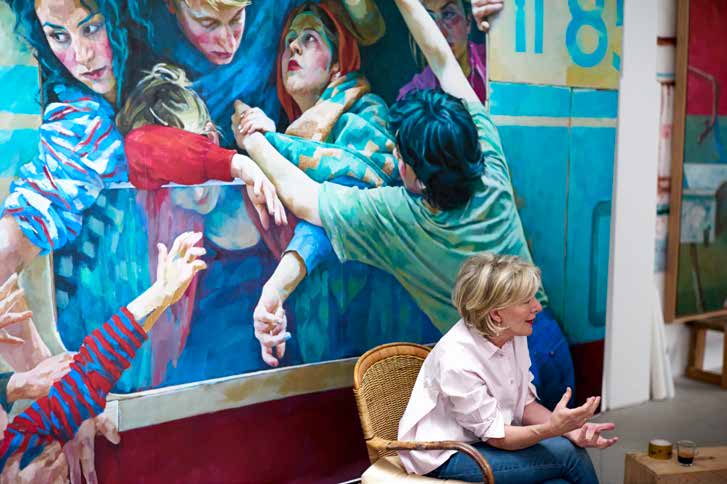
Walt Whitman wrote, “Resist much. Obey Little.” These rebellious feelings register in the faces of the women portrayed by acclaimed international painter Xenia Hausner. Whitman’s words echo in virtually every one of the portraits in Hausner’s recent show at New York’s Forum Gallery. “My characters are disobedient. I am disobedient” says the artist.
The two women in the painting titled, “On Fire” (2018), hold a hammer and a chisel, tools that can be used to destruct or create. Their faces are serious, concentrated, almost sad. The contrast between their sober facial expressions and the painting’s vivid colors and dynamic brush strokes is striking. One of the women wears a bright red hat and an intense blue jacket. She stares at the viewer with an almost threatening gaze. The other woman, blondish hair falling to her shoulders, averts her eyes but at the same time, she clenches her wooden mallet with two hands, ready to attack or defend herself. The back story is lost to us. Like most of Hausner’s portraits, this one is ambiguous and resists definitive interpretation.
The same is true for “Emergency” (2017). Two young women lean against each other. Their situation is unfathomable. They are beautiful, rosy cheeked with red lips and long golden and bright red-orange hair. Whatever they are enduring on this lonely voyage, perhaps on a ship, we never learn.
“Borodino” (2019) portrays three women, two of whom seem to be lost in thought. (The title refers to the 1812 Battle of Borodino, the deadliest of the Napoleonic Wars.) A third woman with short wispy blonde hair in a leopard spotted pale green coat, slightly resembles the artist. She leans on a handrail and stares out at the viewer. The women could be in transit, heading for some unknown destination.
Their situation may be ambiguous, but not the artist’s palette. This painting is all about color. No skin tone is simple. No lipstick is just bright red. Each shade has subtle variations and depth. Eyebrows might be green brown or black, but they are arched and elongated individually. What this demonstrates is the artist’s perfectionism in creating specific characters in striking colors whose inner dramas are hidden from us.
Hausner’s portraits are staged events in specific settings that she builds in her Berlin studio and then invites women to inhabit them. She takes several photographs of her installation before she begins painting.
Relying on her training as a scenic designer, Hausner’s environments are imbued with mystery. “My pictures tell stories that elude a straightforward reading,” she says.
Born in Vienna in 1951, Hausner grew up in an artistic family. (Her father was the Austrian painter Rudolf Hausner, described as the first psychoanalytical painter.) She studied painting at the academy in Vienna and the Royal Academy of Dramatic Arts in London. From 1977 to 1992 She designed more than 100 theater, opera, and film productions. Beginning in 1992, she moved to Berlin where she still lives part of the year and devotes herself to painting and other projects. Recently, this versatile artist designed the sets for the new production of Der Rosenkavalier at the Staatsoper Berlin.
Hausner’s work is powerful, explosive, and exceedingly bold. It has attracted attention and plaudits from galleries and museums around the world. She has been featured in many solo and group exhibitions in Europe, Russia, China, Japan and the United States and has been awarded several prestigious art
prizes. Although still mid-career, her work will be presented in a solo retrospective exhibition at The Albertina Museum in Vienna in April, 2020.
Forum Gallery – 475 Park Avenue, NYC – forumgallery.com





Leave a Comment